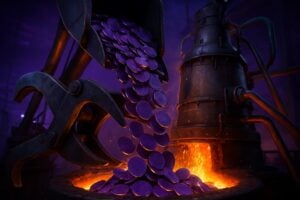In recent months, the world of NFTs has witnessed a significant evolution. If in the past the focus was mainly on digital art, today the focus is shifting towards tangible assets, and at the forefront of this transformation is Polygon, which has recently surpassed Ethereum in terms of weekly sales.
According to the data from CryptoSlam updated as of April 22, NFTs on Polygon generated 22.1 million dollars in weekly sales, recording an increase of 17.64% compared to the previous week. In comparison, Ethereum stopped at 21.8 million, while Mythos Chain and Bitcoin totaled 14.3 million and 14.1 million respectively. This jump led Polygon to hold 24% of the global NFT transaction volume, out of a weekly total of 92.9 million dollars.
But it is not just the sales volume that is impressive. The number of active buyers on Polygon increased by 58.95%, surpassing 14,000 active wallets in just one week. A clear signal that something profound is changing in the NFT landscape.
The boom of NFTs on Polygon: a paradigm shift
Behind the success of Polygon lies a particular project: Courtyard, a platform that unites the physical and digital worlds through the tokenization of real collectible cards. With 20.7 million dollars in weekly sales, Courtyard has surpassed every other NFT collection on any blockchain.
According to the data from DappRadar, in the last 24 hours there have been over 11,000 sales of Courtyard NFTs, representing 11.39% of all global NFT transactions. Among the most sought-after items are the 2016 Pokémon Sun & Moon collection, sold for 147.9 MATIC, the 2022 Pokémon SWSH Black Star promotional card, and the historic 1953 Bowman Color #63 Gil McDougald.
What makes Courtyard truly innovative is its hybrid ownership model. Each collectible is professionally certified and stored in insured vaults managed by Brink’s, one of the most reliable security companies in the world. Users can choose whether to keep their NFT or “burn it” to redeem the physical item, thus combining the liquidity of Web3 with the trust of tangible assets.
NFT and physical assets: new life for the market
Launched in 2022 and supported by Y Combinator, Courtyard raised 7 million dollars with the goal of reinventing the concept of NFT. The platform aims to bridge the gap between traditional collecting and digital trading, offering a more secure, tangible, and meaningful experience compared to the artistic speculations of the past.
This transformation comes at a crucial moment. After the peak of 2021, the NFT market experienced a vertical collapse, with a drop of over 60% by February 2025. The decline, which began at the start of 2024, seemed unstoppable. But in mid-February, an event marked a turning point: the Kanbas Collection purchased a digital artwork for 3 million dollars, reigniting investor interest.
The work, signed by Sam Spratt, a digital artist known for the LUCI series launched on SuperRare in 2021, represented the highest NFT sale of the last three years. LUCI, which blends digital painting and poetic texts, generated 6.2 million dollars in primary sales over ten releases. This success demonstrated that, despite the difficulties, the NFT market still holds strong potential, especially when it comes to high-quality collections.

“`html
Favorable regulation and explosive growth of RWA
“`
“`html
In addition to the resurgence of interest in digital art, another key factor is fueling the new NFT wave: the growth of the real-world asset market (RWA) on blockchain. According to CoinMarketCap, this sector has recorded an expansion of 28,000% since February 2023, reaching a market capitalization of 42 billion dollars.
“`
The regulatory context also seems to be becoming more favorable. On February 21, the U.S. SEC announced the sudden end of the investigation into OpenSea, the main NFT trading platform. The news had an immediate impact on the sector, suggesting a possible softening of the regulators’ stance.
The founder of OpenSea, Devin Finzer, described the event as “a historic victory for our community.” If the SEC had classified NFTs as financial securities, the entire ecosystem could have taken a hard hit. Instead, the decision has instilled new confidence, paving the way for further innovations.
The future of NFTs goes through Polygon and hybrid assets
The success of Polygon and projects like Courtyard demonstrates that the future of NFTs no longer resides solely in digital art, but in the fusion between the physical and digital worlds. The possibility of owning a real asset through a token, with the freedom to trade, store, or redeem it, represents a new frontier for collecting and decentralized finance.
With a recovering market, clearer regulation, and increasingly mature technology, NFTs are entering a phase of maturity. And in this new scenario, Polygon is establishing itself as the reference blockchain for those seeking innovation, security, and real value.
The message is clear: NFTs are not dead, they are just evolving. And this evolution has a name: Polygon.









